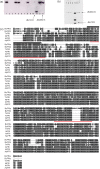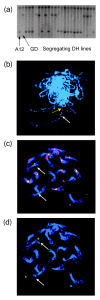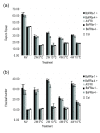Functional alleles of the flowering time regulator FRIGIDA in the Brassica oleracea genome
- PMID: 22333192
- PMCID: PMC3299615
- DOI: 10.1186/1471-2229-12-21
Functional alleles of the flowering time regulator FRIGIDA in the Brassica oleracea genome
Abstract
Background: Plants adopt different reproductive strategies as an adaptation to growth in a range of climates. In Arabidopsis thaliana FRIGIDA (FRI) confers a vernalization requirement and thus winter annual habit by increasing the expression of the MADS box transcriptional repressor FLOWERING LOCUS C (FLC). Variation at FRI plays a major role in A. thaliana life history strategy, as independent loss-of-function alleles that result in a rapid-cycling habit in different accessions, appear to have evolved many times. The aim of this study was to identify and characterize orthologues of FRI in Brassica oleracea.
Results: We describe the characterization of FRI from Brassica oleracea and identify the two B. oleracea FRI orthologues (BolC.FRI.a and BolC.FRI.b). These show extensive amino acid conservation in the central and C-terminal regions to FRI from other Brassicaceae, including A. thaliana, but have a diverged N-terminus. The genes map to two of the three regions of B. oleracea chromosomes syntenic to part of A. thaliana chromosome 5 suggesting that one of the FRI copies has been lost since the ancient triplication event that formed the B. oleracea genome. This genomic position is not syntenic with FRI in A. thaliana and comparative analysis revealed a recombination event within the A. thaliana FRI promoter. This relocated A. thaliana FRI to chromosome 4, very close to the nucleolar organizer region, leaving a fragment of FRI in the syntenic location on A. thaliana chromosome 5. Our data show this rearrangement occurred after the divergence from A. lyrata. We explored the allelic variation at BolC.FRI.a within cultivated B. oleracea germplasm and identified two major alleles, which appear equally functional both to each other and A. thaliana FRI, when expressed as fusions in A. thaliana.
Conclusions: We identify the two Brassica oleracea FRI genes, one of which we show through A. thaliana complementation experiments is functional, and show their genomic location is not syntenic with A. thaliana FRI due to an ancient recombination event. This has complicated previous association analyses of FRI with variation in life history strategy in the Brassica genus.
Figures






Similar articles
-
FRIGIDA-independent variation in flowering time of natural Arabidopsis thaliana accessions.Genetics. 2005 Jul;170(3):1197-207. doi: 10.1534/genetics.104.036533. Epub 2005 May 23. Genetics. 2005. PMID: 15911588 Free PMC article.
-
Establishment of the winter-annual growth habit via FRIGIDA-mediated histone methylation at FLOWERING LOCUS C in Arabidopsis.Plant Cell. 2009 Jun;21(6):1733-46. doi: 10.1105/tpc.109.067967. Epub 2009 Jun 30. Plant Cell. 2009. PMID: 19567704 Free PMC article.
-
Flowering time variation in oilseed rape (Brassica napus L.) is associated with allelic variation in the FRIGIDA homologue BnaA.FRI.a.J Exp Bot. 2011 Nov;62(15):5641-58. doi: 10.1093/jxb/err249. Epub 2011 Aug 23. J Exp Bot. 2011. PMID: 21862478 Free PMC article.
-
Genome Triplication Leads to Transcriptional Divergence of FLOWERING LOCUS C Genes During Vernalization in the Genus Brassica.Front Plant Sci. 2021 Feb 9;11:619417. doi: 10.3389/fpls.2020.619417. eCollection 2020. Front Plant Sci. 2021. PMID: 33633752 Free PMC article. Review.
-
Fine-tuning timing: natural variation informs the mechanistic basis of the switch to flowering in Arabidopsis thaliana.J Exp Bot. 2017 Nov 28;68(20):5439-5452. doi: 10.1093/jxb/erx270. J Exp Bot. 2017. PMID: 28992087 Review.
Cited by
-
De novo assembly of the pennycress (Thlaspi arvense) transcriptome provides tools for the development of a winter cover crop and biodiesel feedstock.Plant J. 2013 Sep;75(6):1028-38. doi: 10.1111/tpj.12267. Epub 2013 Aug 14. Plant J. 2013. PMID: 23786378 Free PMC article.
-
The role of FRIGIDA and FLOWERING LOCUS C genes in flowering time of Brassica rapa leafy vegetables.Sci Rep. 2019 Sep 25;9(1):13843. doi: 10.1038/s41598-019-50122-2. Sci Rep. 2019. PMID: 31554847 Free PMC article.
-
Sequence variation and functional analysis of a FRIGIDA orthologue (BnaA3.FRI) in Brassica napus.BMC Plant Biol. 2018 Feb 13;18(1):32. doi: 10.1186/s12870-018-1253-1. BMC Plant Biol. 2018. PMID: 29433434 Free PMC article.
-
Quantitative trait loci controlling leaf appearance and curd initiation of cauliflower in relation to temperature.Theor Appl Genet. 2016 Jul;129(7):1273-1288. doi: 10.1007/s00122-016-2702-6. Epub 2016 Mar 18. Theor Appl Genet. 2016. PMID: 26993486
-
Genome-Wide Identification of Flowering-Time Genes in Brassica Species and Reveals a Correlation between Selective Pressure and Expression Patterns of Vernalization-Pathway Genes in Brassica napus.Int J Mol Sci. 2018 Nov 18;19(11):3632. doi: 10.3390/ijms19113632. Int J Mol Sci. 2018. PMID: 30453667 Free PMC article.
References
Publication types
MeSH terms
Substances
Grants and funding
- BBS/E/J/000CA321/BB_/Biotechnology and Biological Sciences Research Council/United Kingdom
- BBS/E/J/00000581/BB_/Biotechnology and Biological Sciences Research Council/United Kingdom
- BB/H004602/1/BB_/Biotechnology and Biological Sciences Research Council/United Kingdom
- BBS/E/J/000C0625/BB_/Biotechnology and Biological Sciences Research Council/United Kingdom
- G20334/BB_/Biotechnology and Biological Sciences Research Council/United Kingdom
LinkOut - more resources
Full Text Sources
Molecular Biology Databases

